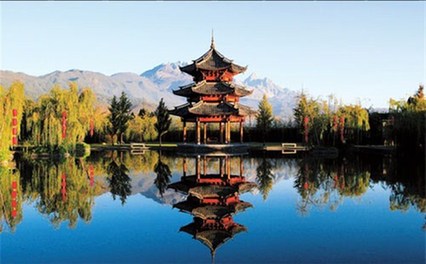Enigma of Shangri-La is shrouded in magnificent scenery
 0 Comment(s)
0 Comment(s) Print
Print E-mail Shanghai Daily, June 4, 2015
E-mail Shanghai Daily, June 4, 2015
|
Visitors to Banyan Tree Lijiang are greeted by a pavilion framed against the Jade Dragon Snow Mountain in the background. — Pete Wong |
The fabled Shangri-La of James Hilton's "Lost Horizons" has long conjured up visions of an earthly paradise set somewhere in a forgotten valley of the Himalayas. Many places have claimed to be the cultural representation of this utopia, but perhaps the most famous where tourism is concerned is northwestern Yunnan Province, which actually has a town now calling itself Shangri-La.
A gust of wind swept across the land causing the Tibetan prayer flags to flap. The first rays of daylight pierced the clouds, bathing the Meili Snow Mountain in a golden hue. We watched Mother Nature orchestrating the morning spectacle as we stood on the rooftop of a hotel in Feilaisi in sub-zero temperatures. Was this the Shangri-La that Hilton wrote about?
Our journey had started a week earlier in Lijiang, a city in Yunnan. In ancient times, traders trekked the arduous "tea and horse trail" from Lijiang to Zhongdian near Deqin County, and then onwards to Lhasa in Tibet. They braved high altitudes and freezing weather on foot and on horseback.
Today, one can retrace part of that route on a modern highway threading through mountain passes and scenic valleys. We stayed a few days in Lijiang to get used to the 2,600-meter altitude before moving north to higher ground. Tourists in Lijiang normally stay in Dayan, the historic old section of town filled with clusters of 800-year-old Naxi-style houses. The locals in Lijiang are mostly from the Naxi ethnic minority group.
Although crowded, the labyrinth of old alleys and time-worn cobblestones still provides pockets of respite where one can have a cup of tea or a meal at one of the many refurbished cafes and restaurants. Dayan is a UNESCO World Cultural Heritage site, hence its popularity. To get away from the crowds, one can head to the lesser known, smaller old town of Shuhe about 4 kilometers away. Other attractions outside Lijiang include the Baisha Murals, Lashihai Lake and, if you have time, the Tiger Leaping Gorge.
From Lijiang, it's a four-hour drive (170 kilometers) north to Shangri-La, a nondescript town that was formerly called Zhongdian before authorities gave it a tourism makeover. As we arrived there, we couldn't help but be taken by the commercial name. Was this the fabled Shangri-La?
Shangri-La is divided into the old district called Dukezong, where tourists normally go, and the newer part of town where locals live. Unfortunately, a big fire in January 2014 razed almost two-thirds of Dukezong. The old town temple, which houses the world's largest Tibetan prayer wheel, escaped the blaze. Many hotels and tourist amenities remain outside the old town area.
Attractions just outside Shangri-La include the Ganden Sumtseling Monastery and Napahai Lake. Sumtseling is the largest Tibetan monastery in Yunnan. It was constructed around 330 years ago in an architectural style resembling the famed Potala Palace in Lhasa. At Napahai, we saw locals working on the banks of the lake, while sheep, cows and horses grazed peacefully along the adjacent grassland.
About 3 kilometers southeast of Shangri-La is Wufeng Mountain, revered as a sacred place by the local Tibetans. The grassland at the foot of the mountain has been used for years to hold popular horse racing events. About 32 kilometers outside Shangri-La, visitors can also visit Bitahai and Shudu lakes. Travel further and you come to the White Water Terraces, a natural wonder created by limestone deposits, and Haba Snow Mountain, a famous nature reserve.







